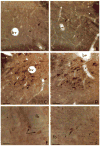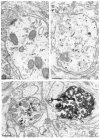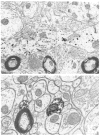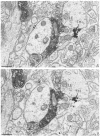Optimization of differential immunogold-silver and peroxidase labeling with maintenance of ultrastructure in brain sections before plastic embedding
- PMID: 1977960
- PMCID: PMC2845158
- DOI: 10.1016/0165-0270(90)90015-8
Optimization of differential immunogold-silver and peroxidase labeling with maintenance of ultrastructure in brain sections before plastic embedding
Abstract
The limited success of immunogold labeling for pre-embedding immunocytochemistry of neuronal antigens is largely attributed to poor penetration of large (5-20 nm) colloidal gold particles. We examined the applicability of using silver intensification of 1 nm colloidal gold particles non-covalently bound to goat anti-rabbit immunoglobulin (1) for single labeling of a rabbit antiserum against the catecholamine synthesizing enzyme, tyrosine hydroxylase (TH), and (2) for immunogold localization of rabbit anti-TH simultaneously with immunoperoxidase labeling of a mouse monoclonal antibody against the opiate peptide, leucine-enkephalin (LE). Vibratome sections were collected from acrolein fixed brains of adult rats. These sections were immunolabeled without use of freeze-thawing or other methods that enhance penetration, but damage ultrastructure. By light microscopy, incubations in the silver intensifier (Intense M, Janssen) for less than 10 min at room temperature resulted in a brownish-red reaction product for TH. This product was virtually indistinguishable from that seen using diaminobenzidine reaction for detection of peroxidase immunoreactivity. Longer incubations produced intense black silver deposits that were more clearly distinguishable from the brown immunoperoxidase labeling. However, by light microscopy, the gold particles seen by electron microscopy were most readily distinguished from peroxidase reaction product with shorter silver intensification periods. The smaller size of gold particles with shorter periods of silver intensification also facilitated evaluation of labeling with respect to subcellular organelles. Detection of the silver product did not appear to be appreciably changed by duration of post-fixation in osmium tetroxide. In dual-labeled sections, perikarya and terminals exhibiting immunogold-silver labeling for TH were distinct from those containing immunoperoxidase labeling for LE. These results (1) define the conditions needed for optimal immunogold-silver labeling of antigens while maintaining the ultrastructural morphology in brain, and (2) establish the necessity for controlled silver intensification for light or electron microscopic differentiation of immunogold-silver and peroxidase reaction products and for optimal subcellular resolution.
Figures





References
-
- Anden NE, Dahlstrom A, Fuxe K, Larsson K. Further evidence for the presence of nigrostiatal dopamine neurons in the rat. Am J Anat. 1965;116:329–334. - PubMed
-
- Andre D, Vuillon Cacciuttolo G, Bosler O. GABA nerve endings in the rat red nucleus combined detection with serotonin terminals using dual immunocytochemistry. Neuroscience. 1987;23:1095–1102. - PubMed
-
- Basbaum AI. A rapid and simple silver enhancement procedure for ultrastructural localization of the retrograde tracer WGA apo HRP-Av and its use in double-label studies with post-embedding immunocytochemistry. J Histochem Cytochem. 1989;37:1811–1815. - PubMed
-
- Broadwell RD, Cataldo AM. The neuronal endoplasmic reticulum: Its cytochemistry and contribution to the endomembrane system. J Histochem Cytochem. 1983;31:1077–1088. - PubMed
-
- Cuello AC. Monoclonal antibodies in neuroanatomical research. In: Chan-Palay V, Palay SL, editors. Cytochemical Methods in Neuroanatomy. Alan R. Liss, Inc; New York, NY: 1982. pp. 151–164.
Publication types
MeSH terms
Substances
Grants and funding
LinkOut - more resources
Full Text Sources

